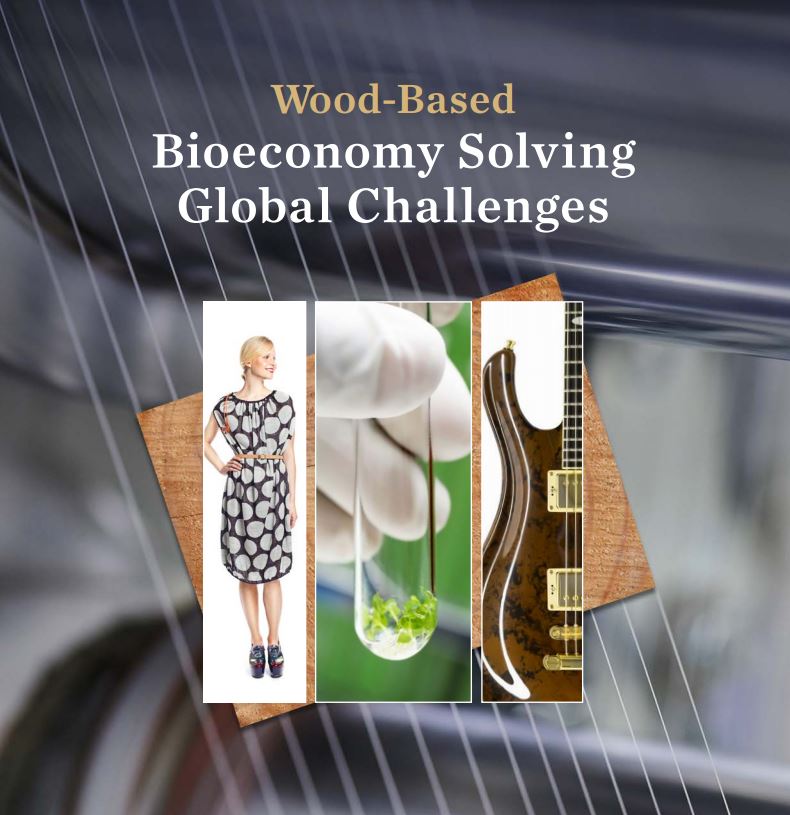Publication: Wood-Based Bioeconomy Solving Global Challenges

Case - Published 29.5.2017
The publication “Wood-Based Bioeconomy Solving Global Challenges”, written by top experts from companies, research institutes and universities of Finland, introduces radical product innovations.
Wood raw materials contain ingredients that have only recently been detected and developed for new uses. Examples include the first biomedical solutions and the production of bioenergy from process waste. Wood-based textiles may at least to some extent in the future free cotton fields to food production globally. The development of fire resistant structural elements of timber and pre-fabrification of wooden blocks of flats enable the breakthrough of multi-storey wooden buildings.
Due to efficient forestry management, the forests in Finland are growing more rapidly than they are used. Forests constitute a carbon sink in Finland, since their annual growth is greater than the volume of trees that are annually harvested. Forest certification has positive effects on the preservation of biodiversity in forests. As a renewable natural resource, ingredients from wood can be valorised in bioproducts providing solutions to problems caused by global warming and waning natural resources.
The articles in the publication convince the reader that the forest industry in Finland is a forerunner in the bioeconomy in global context. The forest sector has traditionally played an important role in the national economy of Finland and over 80 per cent of the land area is covered by forest, representing the highest coverage in Europe. The National Bioeconomy Strategy was published in 2014.
The information, innovation and business ecosystems are closely linked to the bioeconomy. Each ingredient in wood is refined into an end use that provides the best value-added on the market. Traditional mill sites of large forest industry companies are in the process of becoming bio-product mills. Research-based spin-offs and start-ups enrich local knowledge ecosystems and build new value constellations across industrial divides.
The promising new products include biocomposites that can be used in versatile end products. Micro- and nanocellulose possess unique strength and surface properties. Wood lignin can replace fossil materials in various end products. Biochemicals open up new opportunities, as do the second generation biofuels.
Timber construction and the related new innovations and products reduce the carbon footprint of construction, absorb carbon for a long period of time and are sensible solutions in terms of energy efficiency. Research-based evidence is available for the claim that the use of wood in interior solutions has health improving effects. Wood is more relaxing to the eye and, moreover, the use of wood reduces air quality problems.
In addition to the accumulated expertise in the industrial manufacturing of forest products, Finland’s strengths include the strong expertise and know-how in chemistry. Research and innovation projects are strongly supported by the Finnish state. Furthermore, one of Finland’s strengths is higher education, free for EU citizens, and the world’s largest number of qualified engineers in relation to the size of its population.
The publication reminds us about the key role of consumers. Environmental aspects and the idea of sustainable development play a more and more crucial part as consumers choose their lifestyle, products and services. This trend can be strengthened by means of environmental legislation and regulation. New wood-based products can respond to the challenges, whether they are in the field of foods, packing materials or wood-based fibres replacing cotton in the clothing industry.
The publication of the Ministry of Economic Affairs and Employment was introduced in an event organised at the Permanent Delegation of Finland to the OECD in Paris on 29 May 2017.
Download pdf: Wood-Based Bioeconomy Solving Global Challenges
Published on: May 29, 2017
